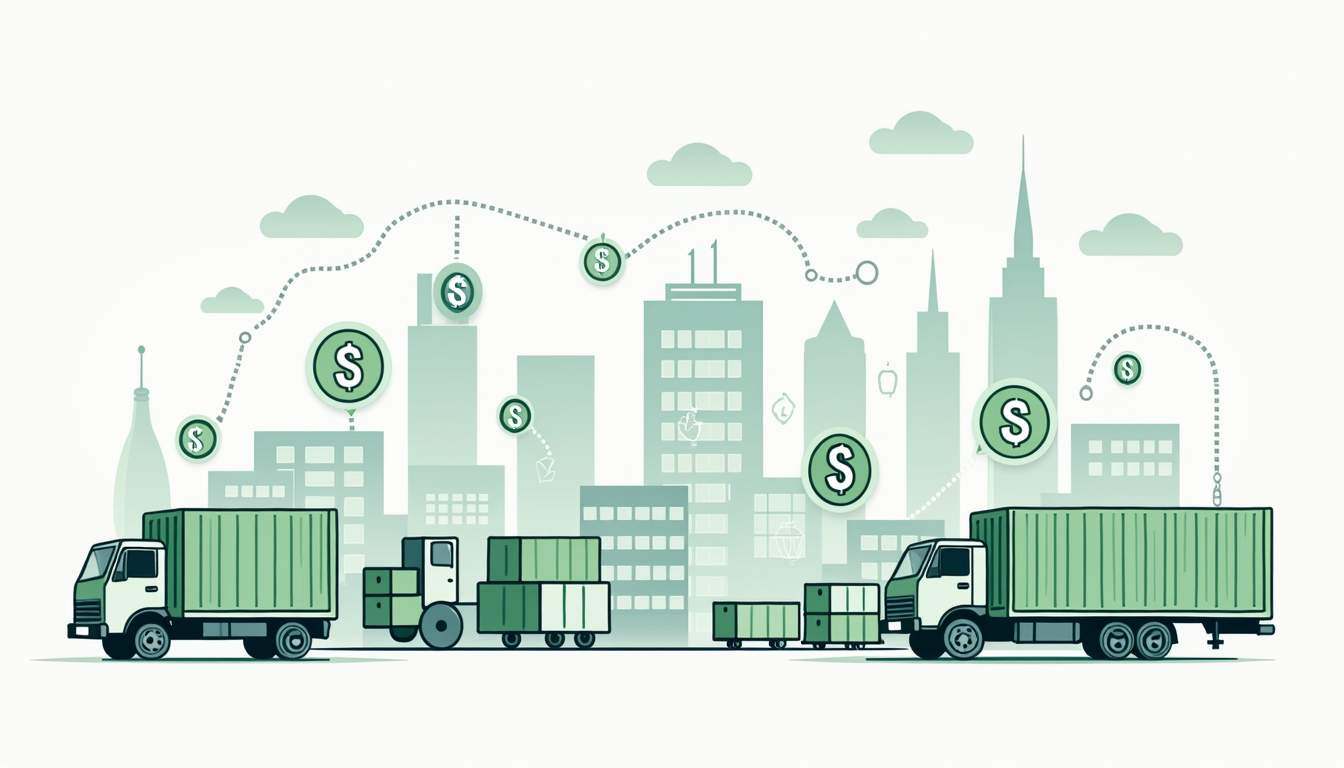Share this
How to Unlock the Rewards of Reverse Logistics Efficiency
by Shipfusion Team on Oct. 28, 2024

While many businesses focus on getting products to customers, managing the flow back is where profits can be lost or found. From hidden operational costs to the impact on customer loyalty, reverse logistics presents both a challenge and an opportunity. Smart brands are leveraging technology to streamline returns, reduce costs, and even turn returns into a competitive advantage. Here's why reverse logistics should be at the center of your strategy – and how you can get it right.
What Is Reverse Logistics and Why Does It Matter?
Reverse logistics refers to the process of moving goods from their final destination back to the manufacturer or the place of origin for the purpose of returns, repairs, remanufacturing, or recycling. Unlike standard logistics that focuses on delivering products to consumers, reverse logistics emphasizes retrieving products and managing them effectively.
The significance of reverse logistics cannot be overstated. The volume of returns received by the average online store has surged dramatically over recent years. According to data from Shopify, the return rate for ecommerce stood at approximately 17.6% in 2023. An upward trend in this number reflects a fundamental shift in consumer behavior as shoppers increasingly prioritize convenience and flexibility in their purchasing decisions.
As a result, businesses are compelled to adopt more sophisticated reverse logistics strategies to maintain customer satisfaction while minimizing costs. A proactive approach not only helps in streamlining operations but also enhances the overall customer experience.
The Hidden Costs of Handling Returned Goods
Handling returned goods involves hidden costs that can severely impact a business’ profitability. These costs may include transportation, restocking, and potential discounts during resale. It’s estimated that processing a return costs upwards of $20 per item, which at scale, isn’t sustainable for a growing company. Products returned in less-than-satisfactory condition can lead to further losses if they cannot be resold at full price.
The environmental impact of returns cannot be ignored. The transportation of returned goods contributes to carbon emissions, and the disposal of unsellable items adds to landfill waste. As sustainability becomes a priority for consumers, companies are increasingly looking for ways to mitigate these impacts, such as by refurbishing returned items or partnering with recycling organizations to ensure responsible disposal.
For many companies, making returns more straightforward for customers is appealing, but the hidden expenses must be accounted for in financial planning. This reality has prompted businesses to explore alternative solutions, such as offering incentives for customers to keep products, or implementing more stringent return policies that encourage thoughtful purchasing decisions.
The Challenges Ecommerce Businesses Face with Reverse Logistics
Ecommerce brands confront a myriad of challenges when managing returns. One significant issue is the lack of visibility over returns data, which can lead to inefficiencies. Without understanding return reasons, businesses may struggle to find effective solutions.
Inventory management becomes particularly complex as returned items can remain untracked, leading to overstocking or stockouts. Additionally, the pressure from customers who expect seamless return processes heightens the stakes, necessitating a strategic approach to reverse logistics. This includes not only refining the return process but also investing in analytics to better understand customer behavior and preferences.
Furthermore, the integration of reverse logistics into the overall supply chain can be a daunting task. Companies must ensure that their systems are capable of handling both forward and reverse flows of goods, which often requires significant investment in technology and training. As the landscape of ecommerce continues to evolve, businesses that can effectively navigate these challenges will be better positioned to thrive in a competitive market, turning potential setbacks into opportunities for growth and customer loyalty.
How Can Ecommerce Brands Improve Reverse Logistics Efficiency?
Improving reverse logistics efficiency is attainable through a multi-faceted approach incorporating technology, process optimization, and data analysis. Many brands are now taking significant steps to address these issues.
Streamlining the Process from Customer to Warehouse
A streamlined process from the customer’s return to the warehouse can minimize delays and improve overall satisfaction. For example, Zara has implemented a system whereby customers can initiate returns through their online accounts, generating return labels instantly. This approach saves time for both the consumer and warehouse staff.
Additionally, the reintegration of returned items into the inventory is crucial. By establishing clear channel logistics, companies can reduce turnaround times for processing returns, allowing for quicker reselling of goods. Furthermore, providing customers with multiple return options, such as drop-off locations or pick-up services, can enhance their experience and encourage repeat purchases. This flexibility not only caters to diverse customer preferences but also helps brands maintain a competitive edge in the market.
Automating Return Processing and Inventory Management
Automation plays a pivotal role in enhancing returns management. Companies like Amazon utilize advanced algorithms to predict returns, allowing them to manage inventory effectively. Automation tools can facilitate sorting and processing returns, reducing the manual labor required.
As a result of these strategies, returns can be handled in real-time, minimizing the backlog often associated with returned goods. This efficiency not only curtails operational costs but also resonates positively with customers. Moreover, integrating machine learning technologies can provide insights into return patterns, enabling brands to identify common issues with specific products. By addressing these root causes, companies can improve product quality and reduce the likelihood of returns in the first place, thereby enhancing overall customer satisfaction and loyalty.
What Technologies Drive Reverse Logistics Efficiency?
Technology serves as a backbone in optimizing reverse logistics, introducing innovations that streamline operations. Brands that embrace technological advancements are often at the forefront of operational excellence.
Leveraging AI and Machine Learning for Faster Processing
Artificial Intelligence (AI) and machine learning have revolutionized returns management. Retailers like eBay utilize these technologies to analyze historical return behavior, enabling predictive analytics that inform their stock management strategies. By understanding what products are likely to be returned, companies can better prepare their supply chains.
This data-driven approach allows for a proactive response, ultimately reducing the frequency and impact of returns. AI also assists in automating communication with customers regarding their return status, enhancing the overall experience. Furthermore, AI algorithms can optimize the routing of returned items to the most appropriate location, whether that’s a restocking center or a liquidation outlet, ensuring that the returned products are handled in the most cost-effective manner possible.
The Role of Smart Warehousing and Real-Time Data
Smart warehousing systems equipped with real-time data capabilities further improve efficiency in reverse logistics. A standout example is Walmart, which employs sensors and tracking technologies to monitor inventory levels and manage returns proactively.
Such systems not only enhance visibility but also enable swift decision-making regarding the disposition of returned goods. Real-time data helps businesses maintain the right stock levels, significantly reducing the chances of overselling. This approach ultimately contributes to a smoother return process.
Additionally, the integration of Internet of Things (IoT) devices allows for seamless communication between various elements of the supply chain, providing insights into the condition and location of returned items. This interconnectedness ensures that businesses can respond quickly to changes in demand and inventory, further refining their reverse logistics strategies.
How Efficient Reverse Logistics Can Save Money and Boost Customer Loyalty
An effective reverse logistics strategy can yield significant financial benefits, fundamentally transforming how businesses operate. The interconnectedness of efficiency and customer satisfaction serves as a critical driver for growing brand loyalty.
Reducing Costs through Optimized Reverse Supply Chains
By optimizing the reverse supply chain, companies can significantly lower costs associated with returns. For instance, leading brands like Best Buy have refined their return policies to encourage in-store returns across their chain of physical locations, thus reducing shipping costs.
With better management of return flows, businesses can negotiate favorable terms with shipping carriers, further enhancing profitability. Improved return processes directly translate into cost savings, allowing these brands to reinvest in customer service and product quality. Additionally, companies can leverage technology such as data analytics to predict return rates and manage inventory levels accordingly, minimizing excess stock and ensuring that they are not losing money on unsold items. This proactive approach not only streamlines operations but also contributes to a more sustainable business model by reducing waste and optimizing resource allocation.
Enhancing the Customer Experience with Seamless Returns
A customer-centric approach to returns not only builds loyalty but also fosters positive brand identity. Companies such as Nordstrom have built a reputation around hassle-free returns, ensuring that the customer feels valued at every step. Their strategy includes no-questions-asked refunds, driving home the message that customer satisfaction is paramount.
By making returns easy, companies enhance the likelihood of repeat purchases. Customers are more inclined to shop at retailers that prioritize fluid return processes. As a result, the overall customer experience improves, which can have a ripple effect on brand perception and consumer advocacy. Furthermore, incorporating user-friendly online return portals and providing clear instructions can significantly reduce the friction often associated with returns. This not only saves time for the customer but also minimizes the workload for customer service teams, allowing them to focus on more complex inquiries and enhancing the overall service quality.
Bolster Your Reverse Logistics Efficiency with Shipfusion
There’s no denying the benefits of leveraging data-driven strategies and incorporating advanced technologies into reverse logistics. Efficient returns processes can lead not only to reduced costs but also to enhanced customer satisfaction and loyalty, creating a win-win situation for both consumers and businesses.
Tap into Shipfusion’s robust reverse logistics system for an easy solution to traditional in-house logistics woes. We handle returned items as diligently as we send them out – at an industry-leading accuracy rate of over 99.9%. Our services are made to scale, so there’s no need to worry about outgrowing operational capacity in any respect. Get in touch with us for a free quote today.
Share this
You May Also Like
These Related Articles

What to Know Before Implementing Reverse Logistics Software for Your Business

Top 15 Best 3PL Services in the USA

What the Best 3PL for Cost Efficiency Looks Like
- September 2025 (2)
- August 2025 (8)
- July 2025 (16)
- June 2025 (22)
- May 2025 (27)
- April 2025 (27)
- March 2025 (26)
- February 2025 (26)
- January 2025 (34)
- December 2024 (16)
- November 2024 (22)
- October 2024 (22)
- September 2024 (27)
- August 2024 (9)
- July 2024 (8)
- June 2024 (5)
- May 2024 (8)
- April 2024 (7)
- March 2024 (6)
- February 2024 (6)
- January 2024 (5)
- December 2023 (3)
- November 2023 (3)
- October 2023 (5)
- September 2023 (4)
- August 2023 (2)
- July 2023 (1)
- June 2023 (4)
- March 2023 (2)
- October 2022 (1)
- September 2022 (5)
- August 2022 (4)
- July 2022 (7)
- June 2022 (4)
- May 2022 (4)
- April 2022 (6)
- March 2022 (2)
- February 2022 (1)
- January 2022 (3)
- December 2021 (2)
- November 2021 (4)
- October 2021 (2)
- September 2021 (5)
- August 2021 (4)
- July 2021 (4)
- June 2021 (3)
- May 2021 (2)
- April 2021 (3)
- March 2021 (3)
- February 2021 (3)
- January 2021 (2)
- December 2020 (4)
- November 2020 (2)
- October 2020 (4)
- September 2020 (2)
- July 2020 (5)
- June 2020 (4)
- May 2020 (2)
- April 2020 (2)
- March 2020 (4)
- February 2020 (1)
- December 2019 (1)
- May 2018 (1)
- March 2018 (2)
- February 2018 (3)
- January 2018 (3)
- November 2017 (3)
- July 2017 (4)
- March 2017 (3)
- February 2017 (5)
- January 2017 (3)
- December 2016 (4)
- November 2016 (6)
- October 2016 (6)
- October 2015 (1)
- September 2015 (1)
- June 2015 (3)
- May 2015 (3)
- August 2014 (1)
- July 2014 (1)
- March 2014 (1)
- February 2014 (1)